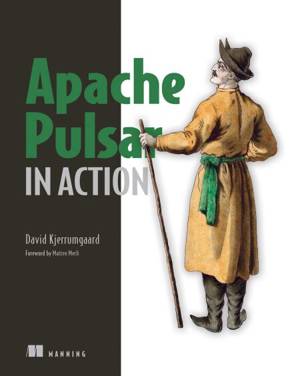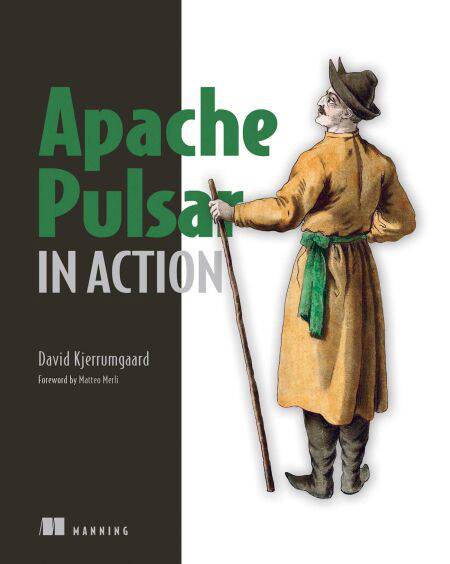
- Afhalen na 1 uur in een winkel met voorraad
- Gratis thuislevering in België vanaf € 30
- Ruim aanbod met 7 miljoen producten
- Afhalen na 1 uur in een winkel met voorraad
- Gratis thuislevering in België vanaf € 30
- Ruim aanbod met 7 miljoen producten
Zoeken
Omschrijving
Deliver lightning fast and reliable messaging for your distributed applications with the flexible and resilient Apache Pulsar platform.
In Apache Pulsar in Action you will learn how to:
Publish from Apache Pulsar into third-party data repositories and platforms
Design and develop Apache Pulsar functions
Perform interactive SQL queries against data stored in Apache Pulsar
Apache Pulsar in Action is a comprehensive and practical guide to building high-traffic applications with Pulsar. You’ll learn to use this mature and battle-tested platform to deliver extreme levels of speed and durability to your messaging. Apache Pulsar committer David Kjerrumgaard teaches you to apply Pulsar’s seamless scalability through hands-on case studies, including IOT analytics applications and a microservices app based on Pulsar functions.
Purchase of the print book includes a free eBook in PDF, Kindle, and ePub formats from Manning Publications.
About the technology
Reliable server-to-server messaging is the heart of a distributed application. Apache Pulsar is a flexible real-time messaging platform built to run on Kubernetes and deliver the scalability and resilience required for cloud-based systems. Pulsar supports both streaming and message queuing, and unlike other solutions, it can communicate over multiple protocols including MQTT, AMQP, and Kafka’s binary protocol.
About the book
Apache Pulsar in Action teaches you to build scalable streaming messaging systems using Pulsar. You’ll start with a rapid introduction to enterprise messaging and discover the unique benefits of Pulsar. Following crystal-clear explanations and engaging examples, you’ll use the Pulsar Functions framework to develop a microservices-based application. Real-world case studies illustrate how to implement the most important messaging design patterns.
What's inside
Publish from Pulsar into third-party data repositories and platforms
Design and develop Apache Pulsar functions
Create an event-driven food delivery application
About the reader
Written for experienced Java developers. No prior knowledge of Pulsar required.
About the author
David Kjerrumgaard is a committer on the Apache Pulsar project. He currently serves as a Developer Advocate for StreamNative, where he develops Pulsar best practices and solutions.
Table of Contents
PART 1 GETTING STARTED WITH APACHE PULSAR
1 Introduction to Apache Pulsar
2 Pulsar concepts and architecture
3 Interacting with Pulsar
PART 2 APACHE PULSAR DEVELOPMENT ESSENTIALS
4 Pulsar functions
5 Pulsar IO connectors
6 Pulsar security
7 Schema registry
PART 3 HANDS-ON APPLICATION DEVELOPMENT WITH APACHE PULSAR
8 Pulsar Functions patterns
9 Resiliency patterns
10 Data access
11 Machine learning in Pulsar
12 Edge analytics
In Apache Pulsar in Action you will learn how to:
Publish from Apache Pulsar into third-party data repositories and platforms
Design and develop Apache Pulsar functions
Perform interactive SQL queries against data stored in Apache Pulsar
Apache Pulsar in Action is a comprehensive and practical guide to building high-traffic applications with Pulsar. You’ll learn to use this mature and battle-tested platform to deliver extreme levels of speed and durability to your messaging. Apache Pulsar committer David Kjerrumgaard teaches you to apply Pulsar’s seamless scalability through hands-on case studies, including IOT analytics applications and a microservices app based on Pulsar functions.
Purchase of the print book includes a free eBook in PDF, Kindle, and ePub formats from Manning Publications.
About the technology
Reliable server-to-server messaging is the heart of a distributed application. Apache Pulsar is a flexible real-time messaging platform built to run on Kubernetes and deliver the scalability and resilience required for cloud-based systems. Pulsar supports both streaming and message queuing, and unlike other solutions, it can communicate over multiple protocols including MQTT, AMQP, and Kafka’s binary protocol.
About the book
Apache Pulsar in Action teaches you to build scalable streaming messaging systems using Pulsar. You’ll start with a rapid introduction to enterprise messaging and discover the unique benefits of Pulsar. Following crystal-clear explanations and engaging examples, you’ll use the Pulsar Functions framework to develop a microservices-based application. Real-world case studies illustrate how to implement the most important messaging design patterns.
What's inside
Publish from Pulsar into third-party data repositories and platforms
Design and develop Apache Pulsar functions
Create an event-driven food delivery application
About the reader
Written for experienced Java developers. No prior knowledge of Pulsar required.
About the author
David Kjerrumgaard is a committer on the Apache Pulsar project. He currently serves as a Developer Advocate for StreamNative, where he develops Pulsar best practices and solutions.
Table of Contents
PART 1 GETTING STARTED WITH APACHE PULSAR
1 Introduction to Apache Pulsar
2 Pulsar concepts and architecture
3 Interacting with Pulsar
PART 2 APACHE PULSAR DEVELOPMENT ESSENTIALS
4 Pulsar functions
5 Pulsar IO connectors
6 Pulsar security
7 Schema registry
PART 3 HANDS-ON APPLICATION DEVELOPMENT WITH APACHE PULSAR
8 Pulsar Functions patterns
9 Resiliency patterns
10 Data access
11 Machine learning in Pulsar
12 Edge analytics
Specificaties
Betrokkenen
- Auteur(s):
- Uitgeverij:
Inhoud
- Aantal bladzijden:
- 400
- Taal:
- Engels
Eigenschappen
- Productcode (EAN):
- 9781638356752
- Verschijningsdatum:
- 27/12/2021
- Uitvoering:
- E-book
- Beveiligd met:
- Adobe DRM
- Formaat:
- ePub

Alleen bij Standaard Boekhandel
+ 41 punten op je klantenkaart van Standaard Boekhandel
Beoordelingen
We publiceren alleen reviews die voldoen aan de voorwaarden voor reviews. Bekijk onze voorwaarden voor reviews.











